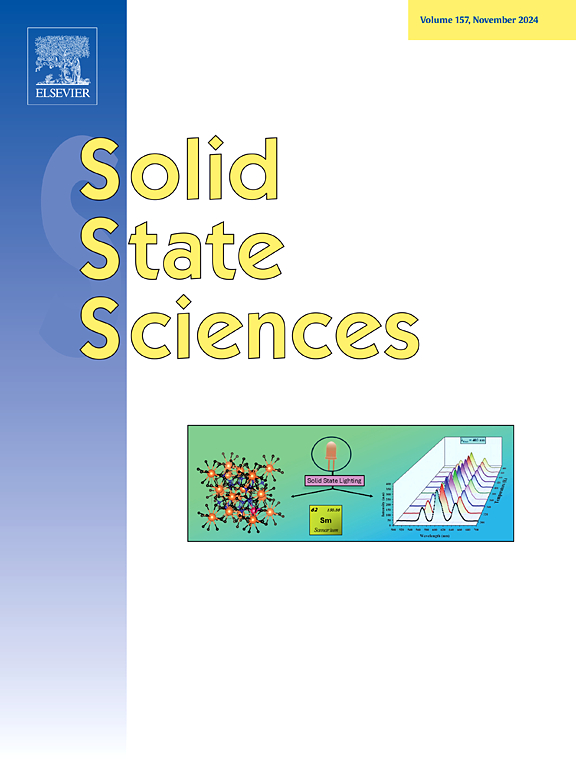Sustainable microwave-assisted crafting of CoZrO3@Graphene nanoplatelets nanocomposites for advanced asymmetric supercapacitors
IF 3.4
3区 化学
Q2 CHEMISTRY, INORGANIC & NUCLEAR
引用次数: 0
Abstract
In response to the growing energy crisis driven by rapid urbanization and population growth, the research investigates the development of high-performance supercapacitor electrode materials. Specifically, CoZrO3 and its composite with graphene nanoplatelets (GNP) were synthesized using a microwave-assisted combustion method. Structural and morphological characteristics were confirmed by X-ray Diffraction (XRD), Fourier Transform Raman, UV–vis diffuse reflectance spectroscopy (UV-DRS), Scanning Electron Microscopy (SEM), Transmission Electron Microscopy (TEM), X-ray photoelectron spectroscopy (XPS) and N2 adsorption/desorption studies. The prepared CoZrO3@GNP nanocomposites exhibited exemplary electrochemical performance by achieving a maximum specific capacitance of 1003 F g−1 at a current density of 2 A g−1. An asymmetric supercapacitor device fabricated with this nanocomposite demonstrated a specific capacitance of 129.05 F g−1 at 2 A g−1, maintaining 89 % of its initial capacitance after 2000 cycles and delivering an energy density of 165.18 W h kg−1 and maximum power density of 9.14 W kg−1. The significant improvements are attributed to the synergistic effects of the GNP integration, highlighting the potential of CoZrO3@GNP as a viable electrode material for advanced energy storage applications.

用于先进不对称超级电容器的CoZrO3@Graphene纳米片纳米复合材料的可持续微波辅助工艺
为了应对快速城市化和人口增长所带来的日益严重的能源危机,本研究探讨了高性能超级电容器电极材料的发展。具体而言,采用微波辅助燃烧的方法合成了CoZrO3及其与石墨烯纳米片(GNP)的复合材料。通过x射线衍射(XRD)、傅里叶变换拉曼(Fourier Transform Raman)、紫外-可见漫反射光谱(UV-DRS)、扫描电子显微镜(SEM)、透射电子显微镜(TEM)、x射线光电子能谱(XPS)和N2吸附/脱附研究证实了其结构和形态特征。制备的CoZrO3@GNP纳米复合材料在电流密度为2 a g−1时的最大比电容达到1003 F g−1,表现出优异的电化学性能。用该纳米复合材料制备的非对称超级电容器器件在2 a g−1时的比电容为129.05 F g−1,在2000次循环后保持初始电容的89%,能量密度为165.18 W h kg−1,最大功率密度为9.14 W kg−1。显著的改进归功于GNP集成的协同效应,突出了CoZrO3@GNP作为先进储能应用的可行电极材料的潜力。
本文章由计算机程序翻译,如有差异,请以英文原文为准。
求助全文
约1分钟内获得全文
求助全文
来源期刊

Solid State Sciences
化学-无机化学与核化学
CiteScore
6.60
自引率
2.90%
发文量
214
审稿时长
27 days
期刊介绍:
Solid State Sciences is the journal for researchers from the broad solid state chemistry and physics community. It publishes key articles on all aspects of solid state synthesis, structure-property relationships, theory and functionalities, in relation with experiments.
Key topics for stand-alone papers and special issues:
-Novel ways of synthesis, inorganic functional materials, including porous and glassy materials, hybrid organic-inorganic compounds and nanomaterials
-Physical properties, emphasizing but not limited to the electrical, magnetical and optical features
-Materials related to information technology and energy and environmental sciences.
The journal publishes feature articles from experts in the field upon invitation.
Solid State Sciences - your gateway to energy-related materials.
 求助内容:
求助内容: 应助结果提醒方式:
应助结果提醒方式:


